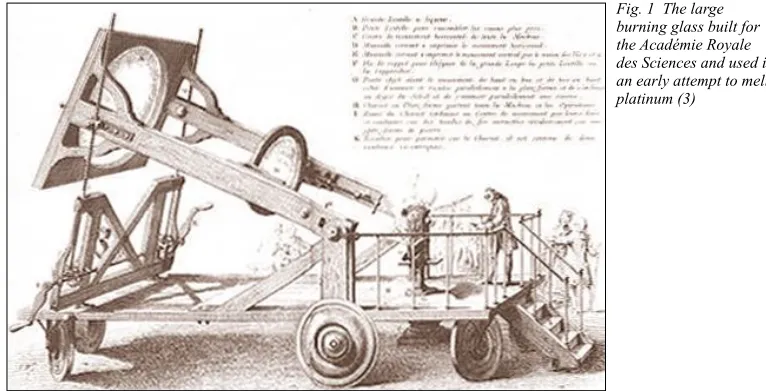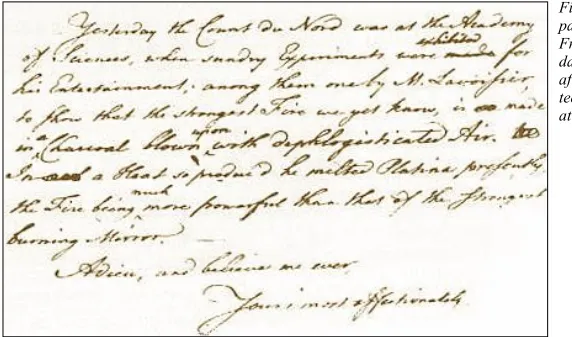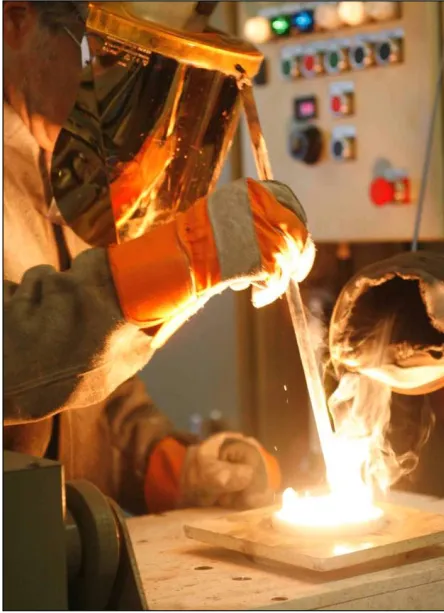Early Attempts to Melt Platinum
Before 1782 little more than a ‘partial agglomer-ation’ of platinum had been achieved, mainly by hot forging from the powder which, although it sufficed to make many platinum artefacts, did not produce homogeneous molten metal (1–3). The first to melt impure platinum may have been Henrik Theophil Scheffer (1710–1759) who in 1751 melted platinum with copper, and later arsenic, in a furnace (4). Franz Achard (1753–1821) similarly melted the metal with arsenic (5). In both cases alloys of platinum, rather than pure platinum, are likely to have been melted. In 1775 Pierre Macquer (1718–1784) and Antoine Baumé(1724–1804) unsuccessfully attempted to melt platinum in a porcelain crucible over a wood fire. Macquer and others (later including Lavoisier) then tried with burning glasses: a 56 cm diameter concave mirror which focused the sun’s rays quickly melted iron but platinum gave only silvery-white glistening particles – the product probably contained impurities of carbon which lowered its melting point (1). In 1774 a magnificent 1.2 m diameter burning glass filled with alcohol was mounted on a carriage and installed in the Jardin de l’Infante, Paris, France: it melted many materi-als, but not platinum (1, 6). An illustration of this device is shown in Figure 1 (3).
Melting the Platinum Group Metals
FROM PRIESTLEY, LAVOISIER AND THEIR CONTEMPORARIES TO MODERN METHODS
By W. P. Griffith
Department of Chemistry, Imperial College, London SW7 2AZ, U.K.; E-mail: w.griffith@imperial.ac.uk
Some fifty years ago Donald McDonald wrote in Platinum Metals Review on ‘The History of the Melting of Platinum’ (1) and Leslie B. Hunt marked the event’s bicentenary in ‘The First Real Melting of Platinum: Lavoisier’s Ultimate Success with Oxygen’ (2), which is also covered in the invaluable “A History of Platinum and its Allied Metals” (3). The topic is revisited and extended here, showing how oxygen, first isolated by Joseph Priestley and Carl Wilhelm Scheele, was used by Antoine Lavoisier to melt platinum. Work on the melting of the other platinum group metals (pgms) and modern methods for melting the metals are also discussed.
DOI: 10.1595/147106709X472507
Priestley, Scheele and the Discovery
of Oxygen
Joseph Priestley (1733–1804) was born in Fieldhead, Birstall, near Leeds in the U.K., and died in Philadelphia, U.S.A. He was better known in the eighteenth century for his radical religious and political beliefs; opposition to these and his enthusiasm for the French Revolution led him to leave the U.K. in 1794. We remember him for his science: photosynthesis, optics, electrostatics, biology and physiology and above all chemistry (7). He discovered many new ‘airs’ – N2O, NO,
NO2, CO, SO2, NH3and SiF4– and investigated
HCl, SO3, Cl2, PH3and N2. He discovered oxygen
on 1st August 1774, by heating mercuric oxide (HgO) with a burning glass, and showed that it supported combustion (8–11). He called it ‘dephlogisticated air’, believing in phlogiston, the alleged principle of combustion, to the end. Phlogiston features in one of his last papers, which also describes experiments on dissolving platinum in aqua regia (12). In October 1774, trav-elling in France with his patron the statesman Lord Shelburne, Priestley dined with Lavoisier and told him that he had obtained ‘a new kind of air’ by heating HgO (11).
Carl Wilhelm Scheele (1742–1786), a Swedish pharmacist for whom chemistry was a rewarding hobby, rivals Priestley in the extent of his discov-eries. He was the first to isolate chlorine (in 1774), HF and HCN, and did fundamental work on NH3, HCl, compounds of Ba, Mn, Mo, Ce, P
and on several organic compounds. He made oxygen between 1773 and 1775 by heating MnO2,
KNO3, HgO, HgCO3, MgNO3or Ag2CO3, calling
it ‘vitriol air’ (aer vitrolicus) or ‘fire air’ (aer nudus); he too was a phlogistonist until he died. His paper on oxygen was submitted in 1775 but not published until 1777 (13) so Priestley did not
Lavoisier, Oxygen and the Melting
of Platinum
Antoine Lavoisier (1743–1794) is a supreme figure in chemistry, a pivotal contribution being his refutation of the phlogistic theory (10, 15, 16). There is some controversy as to whether Lavoisier discovered oxygen independently (10, 17, 18) – he was not averse to letting people think this. However, in his paper on the melting of plat-inum (19) Lavoisier did grudgingly allude to Priestley’s priority: “...cet air, que M. Priestley a
décou-vert à peu-près dans la même temps que moi, & je croi même avant moi…” (…this air, which M. Priestley
discovered about the same time as I, and I believe even before me…) – although some of his later publications omit the last phrase. Unlike Priestley, however, he began to understand the real signifi-cance of oxygen. In 1778 he refers to a principe
oxygine (20), and in the first edition of the 1789
edition of his textbook (21) – after melting plat-inum – he refers to oxygène, from οξυζ(acide) and γενηζ (j’engendre – ‘I beget’ or ‘I generate’). He believed oxygen to be an element which was a constituent of all acids.
nobleman. Benjamin Franklin (1706–1790), a friend and supporter of the often penniless Priestley, was also present, writing to Priestley that: “Yesterday the Count du Nord was at the Academy of Sciences, when sundry Experiments were exhibited for his Entertainment; among them, one by M. Lavoisier, to show that the strongest Fire we yet know, is made in a Charcoal blown on with dephlogisticated air. In a Heat so produced, he melted Platina presently, the Fire being much more powerful than that of the strongest burning mirror” (22), Figure 3 (3).
Although neither Lavoisier, Priestley nor Scheele could have realised it, the ability of oxygen to support combustion, a process which emits the
degree of intense heat needed to melt platinum, arises largely from the intrinsic weakness of its O–O bond (496 kJ mol–1) (23). This weakness and
consequent facile bond cleavage arises from elec-tron lone pair-lone pair repulsions between the atoms in the O2molecule. The heat emitted from,
for example, charcoal burning in an H2-O2mixture
arises from the formation of the much stronger C=O bonds in CO2 and O–H bonds in H2O
which are the products of combustion.
Later Methods for Melting Platinum
and the Other PGMs
Lavoisier’s method was not suited to large-scale production of molten platinum. In 1816 William Fig. 2 A drawing by Madame Marie Anne Paulze Lavoisier of the apparatus designed by Lavoisier to burn continuous streams of oxygen and hydrogen (3)
Hyde Wollaston (3) wrote to the Cambridge mineralogist Edward Clarke (1769–1822), suggest-ing that he might try to melt iridium and the native alloy osmiridium. Clarke used a blowpipe with an H2-O2 mixture. Despite several
explo-sions he melted 0.5 ounces of the metal, writing that it melted more quickly than did lead in a fire (24). He also melted palladium, rhodium, iridi-um and native osmiridiiridi-um (25). Another early claim was made for melting of rhodium by a ‘hydro-pneumatic blow pipe’ (26). A different approach was to fuse the metal by placing it between the poles of a large voltaic battery. John Frederic Daniell (1790–1845), using seven-ty large copper/zinc-sulfuric acid cells in series, melted platinum, rhodium, iridium and native osmiridium (27).
The work of Henri Sainte-Claire Deville (1818–1881) and Jules Henri Debray (1827–1888) led the way to large-scale production of molten platinum. Their furnace used two large hollowed-out blocks of lime containing the metal, fired by a coal gas-oxygen mixture; the refractory lime absorbed the slag formed by oxidation of base metal impurities. They melted a 600 g sample of platinum in 1856 (28, 29), and this remained the method of choice for melting platinum until induction furnaces became available in the early twentieth century.
In 1855 George Matthey (1825–1913) visited the Paris Exhibition of 1855 and there met Debray, who in 1857 offered him the British rights for his method for melting platinum. By 1861 the process was in commercial use by Johnson Matthey and Company at Hatton Garden in London, U.K. In 1862 Deville came to London, and with Matthey melted a huge 100 kg ingot of platinum. The production of platinum, in the hands of Johnson Matthey, passed from a
labora-tory procedure to a full-scale operation, making the metal available worldwide.
Michael Faraday (1791–1867) tried but failed to persuade Deville to demonstrate his method at the Royal Institution of Great Britain. Instead, in one of his last discourses there, entitled ‘On Platinum’, Faraday demonstrated its melting by using a ‘voltaic battery’, mentioning that “if you go into the workshops of Mr. Matthey [you will] see them hammering and welding away [at plat-inum]…”. He noted that five of the six pgms had been melted, the exception being osmium. He wrote that ruthenium has the highest melting point, followed by iridium, rhodium, platinum and finally palladium (30). Faraday also referred to platinum in his celebrated “Chemical History of a Candle” (31).
Melting Points of the PGMs
It was not until the late nineteenth and early twentieth centuries that reliable pyrometers were devised for determining melting points (32, 33). Table I lists modern values for their melting and boiling points (34); osmium has the highest values for both (35).
Current Methods for Melting the
PGMs
Early methods for melting the pgms used blow-pipe procedures, while Daniell used electricity. These days the same basic procedures are still used, albeit with newer techniques.
Oxy-hydrogen or oxy-propane blowpipes or torches are still in use for bench-scale repair of platinum jewellery (36, 37), and certainly tempera-tures as high as 2500ºC and probably higher can be reached.
for large-scale jewellery manufacture (see Figure 4). Induction heating, derived from Faraday’s dis-covery in 1831 (38) of electrical induction, uses high-frequency alternating current passed through a water-cooled copper coil surrounding a refracto-ry crucible containing the metal sample. Electron beam heating uses a refractory cathode, often tungsten or molybdenum: the electrons from this are accelerated in vacuo by a high-voltage direct cur-rent source to the metal (which becomes the anode) in a refractory container, the beam being steered by a magnetic field. Energies developed can reach 150 keV, and material can be melted at temperatures above 2100ºC. Finally, in arc melt-ing, which can be traced back to Humphry Davy’s early experiments with a voltaic pile, the arc is struck under argon between a tungsten cathode and the metal which rests on a water-cooled cop-per anode. A direct current potential of 50 V to 80 V and a current of several hundred amperes is commonly used. The technique melts tungsten
(which has a melting point of 3422ºC), and so can melt all six pgms. These methods have been well described, although without reference to pgms (39), and there is a recent history of the induction method (40).
For larger quantities of platinum or palladium (1 kg to 20 kg), induction heating is the quickest and most effective procedure. The metal charge is held in alumina or zirconia crucibles and is typi-cally melted in air since oxidation is not a problem for these metals. Graphite or copper alloy moulds form the ingots and the molten metal is poured by an automated procedure.
For the higher-melting iridium and rhodium, induction heating is less suitable. For these, arc melting is used for smaller quantities, usually less than 1 kg, and is effected in an inert gas atmos-phere with the charge held in a water-cooled copper alloy mould. A tungsten cathode generates and maintains the arc, which is moved over the metal to melt and consolidate it. Electron beam
melting is used to make larger ingots: an evacuat-ed chamber is usevacuat-ed under a vacuum in excess of 10–4 Torr, with the metal held in water-cooled
copper alloy moulds as for arc melting. As with the latter technique, several melting sequences are required with the ingot being turned over several times to ensure complete and even melting. Ingot sizes are typically between 2 kg and 15 kg (41). There is a recent paper in this Journal providing information on the melting of iridium (42).
Conclusions
The discovery and production of gaseous oxy-gen, by Scheele and Priestley, allowed the first melting of pure platinum by Lavoisier in the late
18th century. The other platinum group metals were melted during the early 19th century, and by the mid-19th century commercial-scale production of platinum had become possible for the first time. The methods developed during this period remained in use until the early 20th century, when modern methods of industrial scale production using electrical heating became possible.
Acknowledgements
I am grateful to the editorial and technical staff of Johnson Matthey for information on modern procedures for melting the pgms, and to Dr Max Whitby, Imperial College London, U.K., for gen-eral advice on these aspects.
1 D. McDonald, Platinum Metals Rev., 1958, 2, (2), 55 2 L. B. Hunt, Platinum Metals Rev., 1982, 26, (2), 79 3 D. McDonald and L. B. Hunt, “A History of Platinum
and its Allied Metals”, Johnson Matthey, London, U.K., 1982
4 H. T. Scheffer, Kungl. Vetensk. Akad. Handl., 1752, 13, 269–276
5 F. K. Achard, Nouv. Mém. Acad. R. Sci. Berlin, 1781, 12, 103
6 J. C. P. Trudaine de Montigny, P. J. Macquer, L. C. Cadet, A. Lavoisier and M. J. Brisson, Mém. Acad. R. Sci., 1774, 88, 62
7 “Joseph Priestley: A Celebration of His Life and Legacy”, eds. J. Birch and J. Lee, The Priestley Society, Birstall, South Yorkshire, U.K., 2007
8 J. Priestley, “The Discovery of Oxygen, Part 1”, Experiments by Joseph Priestly, LL.D. (1775); Alembic Club Reprints, No. 7, W. F. Clay, Edinburgh, 1894, p. 8
9 W. P. Griffith, Notes Rec. R. Soc. Lond., 1983, 38, (1), 1
10 W. H. Brock, “The Fontana History of Chemistry”, Fontana Press, London, U.K., 1992, 744 pp 11 J. Priestley, “The Doctrine of Phlogiston Established,
and That of the Composition of Water Refuted”, 2nd
14 U. Bocklund, ‘A Lost Letter from Scheele to Lavoisier’, Lychnos, 1957–58, 39
15 A. Lavoisier, Mém. Acad. R. Sci., 1775, 429 (issued in 1778); Reprinted in “Œuvres de Lavoisier”, Imprimerie Impériale, Paris, 1862, Vol. 2, p. 122
16 A. Lavoisier, Mém. Acad. R. Sci., 1783, 505 (issued in 1786); Reprinted in “Œuvres de Lavoisier”, Imprimerie Impériale, Paris, 1862, Vol. 2, p. 623
17 J. Priestley, “Experiments and Observations on Different Kinds of Air”, 2nd Edn., Printed for J. Johnson, London, U.K., 1784, Vol. 2, p. 34 18 S. J. French, J. Chem. Educ., 1950, 27, 83
19 A. Lavoisier, Mém. Acad. R. Sci., 1782, 457 (issued in 1785); Reprinted in “Œuvres de Lavoisier”, Imprimerie Impériale, Paris, France, 1862, Vol. 2, p. 423 20 A. Lavoisier, Mém. Acad. R. Sci., 1778, 535 (issued in
1781); Reprinted in “Œuvres de Lavoisier”, Imprimerie Impériale, Paris, France, 1862, Vol. 2, p. 248 21 A. Lavoisier, “Traité Eléméntaire de Chimie”, 1st Edn.,
Cuchet, Paris, France, 1789, Vol. 1, p. 48
22 “The Writings of Benjamin Franklin”, ed. A. H. Smyth, in 10 volumes, Macmillan, London, U.K., 1906, Vol. VIII, p. 453
23 H. M. Weiss, J. Chem. Educ., 2008, 85, (9), 1218 24 E. D. Clarke, Thomson’s Ann. Philos., 1817, 9, 89
30 M. Faraday, Chem. News, 1861, 3, 136
31 M. Faraday, “A Course of Six Lectures on the Chemical History of a Candle: to Which is Added a Lecture on Platinum”, ed. W. Crookes, Griffin, Bohn, and Company, London, U.K., 1861, p. 173 32 H. L. Callendar, Philos. Mag., 1899, 47, 191 33 Circular of the National Bureau of Standards, No. 7,
U.S. Department of Commerce, Washington, D.C., U.S.A., 1910
34 J. W. Arblaster, Platinum Metals Rev., 2007, 51, (3), 130 35 J. W. Arblaster, Platinum Metals Rev., 2005, 49, (4), 166 36 Platinum Guild International, Technical Articles: http://www.platinumguild.com/output/Page2414.asp
(Accessed on 21st July 2009)
37 Platinum Guild International, Technical Videos: http://www.platinumguild.com/output/Page1749.asp (Accessed on 21st July 2009)
38 M. Faraday, Phil. Trans. R. Soc. Lond., 1832, 122, 125 39 A. C. Metaxas, “Foundations of Electroheat: A Unified Approach”, John Wiley & Sons, Chichester, U.K., 1996
40 A. Mühlbauer, “History of Induction Heating and Melting”, Vulkan Verlag, Essen, Germany, 2008 41 Johnson Matthey Noble Metals, Private communication,
20th March 2009
42 E. K. Ohriner, Platinum Metals Rev., 2008, 52, (3), 186
The Author



